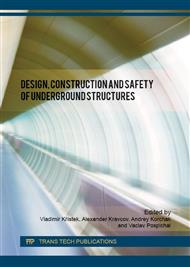p.1
p.11
p.17
p.25
p.33
p.36
p.45
p.51
Assessment of Factors Affecting the Final Value of «Volume Loss» by TBM Tunneling
Abstract:
This paper covers design diagrams and algorithms for determining the strain state of soil mass in case of its underworking. When tunnels are constructed in restrained urban conditions peculiar to megapolises, there is an acute problem related to the assessment of their influence on the existing above-and underground facilities. The strains of buildings and structures that occur as a result of underground construction work may have an impact on the operation reliability of these facilities. Russian regulatory documents in the area of underground urban construction strictly govern the basic parameters of the subsidence trough, such as maximum vertical subsidence, curvature, inclination, etc., for most of the existing underworked structures. Such facilities include both buildings and structures of various purposes above ground and different types of utilities (roads and railways, pipelines, cable lines, etc.). The method described in the paper offers the use of an integral quantity of "volume loss" when tunneling is performed by tunnel-boring machines. The "volume loss" term shall be understood to mean the distance between tunnel lining and soil mass, which initially occurs due to the difference between rotor diameter and lining outside diameter. There are also a number of other technology factors affecting the increase of this parameter, and their quantitative assessment is given in this paper. The method proposed in this paper makes it possible to promptly assess the impact of tunneling operations on the existing underworked structures with account of basic influencing factors.
Info:
Periodical:
Pages:
1-10
Citation:
Online since:
July 2016
Authors:
Keywords:
Price:
Сopyright:
© 2016 Trans Tech Publications Ltd. All Rights Reserved
Share:
Citation:


